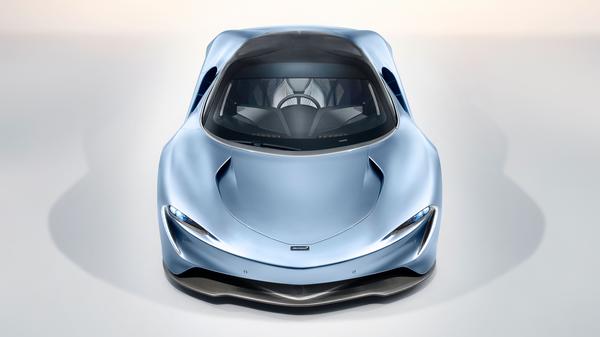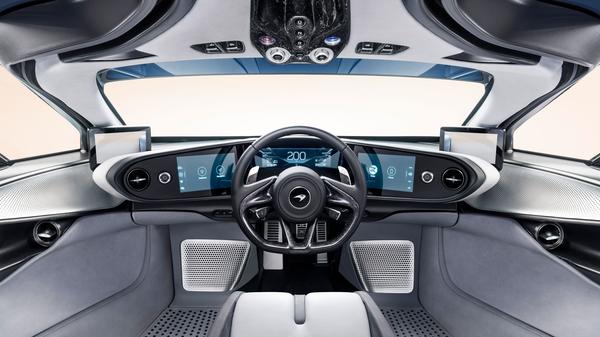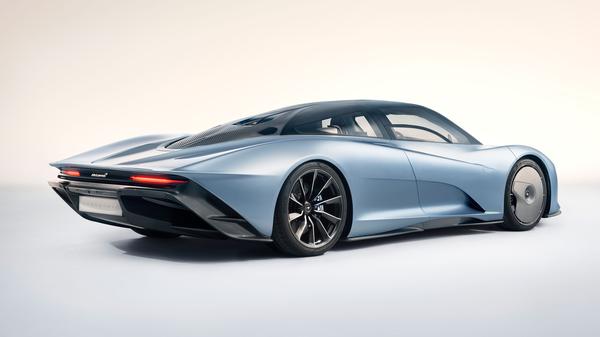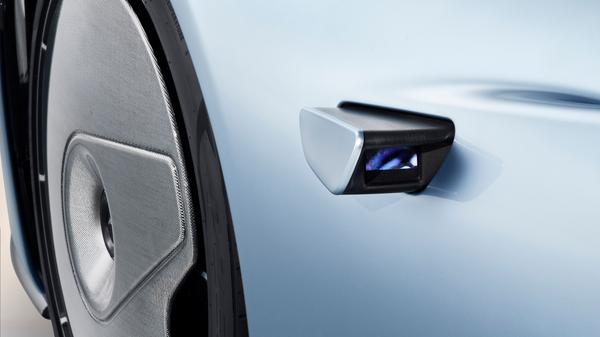News
McLaren’s new £1.75 million Speedtail hypercar
This three-seater, 250mph monster is inspired by the classic McLaren F1 of the 1990s. Just 106 will be made, and they’ve all been sold.


Words by: Erin Baker
Published on 26 October 2018 | 0 min read
- 0-186mph in 12.8 seconds
- 106 examples to be built
- First deliveries 2020
McLaren has finally taken the covers off its £1.75 million hybrid hypercar, the Speedtail.
Described by McLaren as the ultimate GT for the road, the Speedtail echoes the McLaren F1 three-seater supercar of the ‘90s, and like the brand’s icon ahas three seats and is limited to 106 examples. Each Speedtail is already sold, and there’s a waiting list of twice that for any cancellations, even though the cars won’t be delivered to customers until 2020. Unlike the equally outrageous McLaren P1 hybrid hypercar, the Speedtail will not have an electric-only mode. Instead, the battery cells and motors are there simply to increase acceleration and the car’s top speed. It’s so fast that McLaren haven’t even bothered to announce a 0-62mph time (although it’ll be well under three seconds), but McLaren is committing the car to a 0-186mph (300km/h) time of 12.8 seconds, and a top speed of 250mph.
Described by McLaren as the ultimate GT for the road, the Speedtail echoes the McLaren F1 three-seater supercar of the ‘90s, and like the brand’s icon ahas three seats and is limited to 106 examples. Each Speedtail is already sold, and there’s a waiting list of twice that for any cancellations, even though the cars won’t be delivered to customers until 2020. Unlike the equally outrageous McLaren P1 hybrid hypercar, the Speedtail will not have an electric-only mode. Instead, the battery cells and motors are there simply to increase acceleration and the car’s top speed. It’s so fast that McLaren haven’t even bothered to announce a 0-62mph time (although it’ll be well under three seconds), but McLaren is committing the car to a 0-186mph (300km/h) time of 12.8 seconds, and a top speed of 250mph.

Such rapid acceleration comes courtesy of 1,050 horsepower from the engine/battery combo. Details on the powertrain will be held back until the Geneva Motor Show next March, but McLaren has said that the battery will be charged wirelessly through an induction plate screwed to the bottom of the car, which then drives over a charging pad to suck up the power. Each customer will get a charging pad installed at their home as part of the purchase price.
To achieve the Speedtail’s eyeball-crushing speed, the car will be built to a weight of just 1,430kg, which is incredibly light for a car with an engine, battery and motors. The McLaren diet consists of a carbon-fibre body, aluminium suspension and carbon ceramic brakes. The interior, however, has not undergone the same extreme paring-back, because McLaren wants this car to be a grand tourer, used to travel vast distances in comfort. The three seats are clothed in soft leather, which also covers the footwells. The driver sits in the centre of the car, with two rear passengers positioned either side of the driver, their seats slightly overlapping with the one in front, so the driver will get a good view of his passengers’ legs. The front dash wraps around the driver, with a range of screens to display all functions curving round the inside, while the automatic gearbox buttons - D for Drive, etc - sit above the driver in the ceiling.
To achieve the Speedtail’s eyeball-crushing speed, the car will be built to a weight of just 1,430kg, which is incredibly light for a car with an engine, battery and motors. The McLaren diet consists of a carbon-fibre body, aluminium suspension and carbon ceramic brakes. The interior, however, has not undergone the same extreme paring-back, because McLaren wants this car to be a grand tourer, used to travel vast distances in comfort. The three seats are clothed in soft leather, which also covers the footwells. The driver sits in the centre of the car, with two rear passengers positioned either side of the driver, their seats slightly overlapping with the one in front, so the driver will get a good view of his passengers’ legs. The front dash wraps around the driver, with a range of screens to display all functions curving round the inside, while the automatic gearbox buttons - D for Drive, etc - sit above the driver in the ceiling.

There’s a wonderfully named Unique Velocity mode, which lowers the Speedtail by 35mm and alters the aerodynamics, which are the cleverest part of the car and incorporated of the sleek, long, teardrop-style design. Drag is lowered by removing any notion of wing mirrors. Instead, side cameras pop out of the bodywork when needed to relay an image onto large screens inside the car. The other startling sign of aerodynamics is the solid front wheel covers. Made of more carbon fibre, they remain static as the wheel spins, with air passing between the covers and the wheels, reducing turbulence around the wheels. Without these covers, the acceleration times wouldn’t be possible. At the rear are two barely visible flaps of bodywork, called ailerons, which are made of flexible carbon-fibre. They can lift hydraulically out of the body of the car, to provide downforce at speed or an airbrake function under braking.
Each Speedtail will go through McLaren’s Special Operations (MSO) department, which will decorate and accessorise the car to the owner’s specification, with the result that no two Speedtails will be alike. As an example, the car we’ve seen had a McLaren badge on the bonnet made of carbonfibre weaved with gold, made in Birmingham by the people who make the FA Cup. It’s a £50k option, of course.
Each Speedtail will go through McLaren’s Special Operations (MSO) department, which will decorate and accessorise the car to the owner’s specification, with the result that no two Speedtails will be alike. As an example, the car we’ve seen had a McLaren badge on the bonnet made of carbonfibre weaved with gold, made in Birmingham by the people who make the FA Cup. It’s a £50k option, of course.
